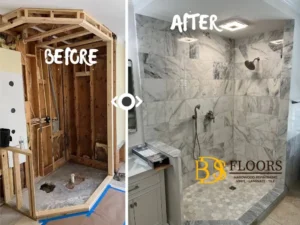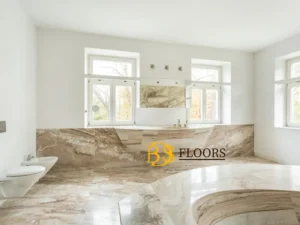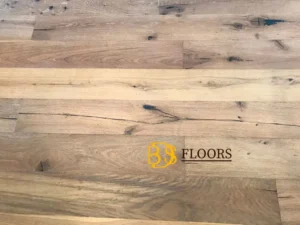Discover these proven techniques to eliminate scratches, dents, and abrasions and restore the elegance of wooden floors.
Wooden floors are a valuable addition to any home, but they require proper maintenance to retain their beauty. Natural wood is prone to surface wear, water damage, and deeper scratches. Prevention is essential, such as using area rugs and protective pads to move furniture, avoiding wearing shoes indoors, and keeping pet nails trimmed.
The finish of your floor acts as a protective layer against daily wear and tear. To maintain it, you need to know the type of finish your floor has. For instance, if your wood floor was installed before 1970, it was likely finished with varnish or shellac. To enhance its shine, you can use paste or liquid wax, or oil. If the older finish has noticeable scratches, it can be stripped or sanded down, and then refinished with a polyurethane-based product. This finish is highly durable, resistant to abrasion, and easy to clean, but ensure that only a water-based silicone polish is used on polyurethane-finished floors.
In cases where extensive wear and tear is noticeable, it may be necessary to completely refinish the floor, which can be a time-consuming and labor-intensive task best handled by professionals. However, for minor marks and discoloration, the following scratch repair tips can help minimize or even completely eliminate the damage, allowing you to restore your wood floors to their previous state of magnificence.
1. Clean hardwood floors gently.
Dull-looking wood floors can make scratches and worn-out areas more prominent, and dirt particles embedded in hardwood floors can exacerbate the issue by causing additional scratches. Therefore, your initial step should involve gentle and thorough cleaning. Avoid using brooms or abrasive scrub pads, and never saturate a floor with water or liquid cleaner. Instead, utilize a soft mop or vacuum cleaner (with the appropriate attachment) to eliminate dust, hair, and surface debris. For cleaning, add two to four drops of liquid soap to a quart of water, combine it in a spray bottle, and spritz your polyurethane-finished floor. Then, disperse the solution using a dry microfiber mop.
Afterward, lightly spray with clean water and polish with a soft, dry cloth. You can also buy commercial non-toxic wood cleaners that are safe for polyurethane-finished floors. A recommended option is a water-based product that includes biodegradable cleaning agents, such as Begley’s, which is available at major home improvement stores and Amazon.

2. Sand out the scratches in the wood floor.
Eliminate scratches from the wood floor by sanding them out.
You can restore the beauty of wood floors with a little bit of effort. To eliminate damage, all you need is fine-grained sandpaper. Start by sanding the floor in the direction of the grain. Since you’ll have to reapply any stain that has been sanded away, choose a concealed area (such as under the bed or in a closet) to test a wood stain that matches your floor color. Once you’ve found the appropriate stain, conduct a patch test on a urethane finish.
Water-based urethane finishes (example available on Amazon) dry quickly and produce a clear, glossy finish that is ideal for newer floors. However, it may result in too much contrast if your floors have darkened with time.
Oil-based urethane finishes (example available on Amazon) have a strong odor, but they dry with a yellow tint that darkens over time, which may complement the color of an older floor. Make sure the area you sanded is smooth and thoroughly cleaned before applying stain and finishing.
3. Rub walnuts over scratches in the wood to camoflage them.
Walnuts have natural emollients and brown dyes that can repair and enhance the appearance of scratched wood. Warm up the oil inside the nut by rubbing it with your fingers, then apply it to the worn areas of the floor using small circular motions. Allow the oil to sit for a few minutes before buffing it with a soft cloth. Coconut oil is also useful for minimizing scratches on unfinished or newly sanded floors. To achieve a richer-looking wood, apply a thin layer of coconut oil with a brush or sponge, wait for five minutes, and then buff with a soft cloth.
4. Make an effective refresher from pantry ingredients.
Combining baking soda and olive oil can be an effective way to decrease and eliminate scratches on wood floors. First, vacuum your floor thoroughly, then apply baking soda that has been dampened with a few drops of olive oil to the scratched areas. After waiting for five minutes, gently buff the mixture into the wood with a soft sponge. Finally, clean the floor with a damp cloth and dry it with a towel.
5. Consider wood floor products designed for scratch repair.
If you want an easy solution for repairing scratches on your wood or laminate floor, you might want to try using a specific product that’s designed for that purpose. Scratch Away is a popular product that not only cleans and polishes the surface but also reduces the visibility of scratches caused by everyday wear and tear, such as furniture scrapes, pet scratches, and shoe marks. You can find it at Lumber Liquidators for $10.99 for an eight-ounce bottle. Another option is Old English Scratch Cover, which costs $4.82 for an eight-ounce bottle on Amazon and comes in light and dark wood tones. This nourishing oil not only hides unsightly scuff marks but also protects the surface. You only need to apply it with a soft cloth on a clean wood surface.
6. Color in scratches with a wood stain.
To reduce the visibility of deep scratches, you can use wood stain which is available in different types such as oil-based, water-based, gel, and combination. Oil-based stains offer a long-lasting and rich color, but dry slowly and can be challenging to use. On the other hand, water-based stains come in various shades and are easy to apply and clean up. Combination stains are suitable for use on polyurethane finishes, while gels do not penetrate the surface and can be applied to different materials, including painted wood.

7. Shine and revive with a specialized care product.
Select a specialized product designed to revive your hardwood floor and give it a shiny appearance. Minwax Hardwood Floor Reviver is a good option that does not require sanding or buffing. Before application, ensure that the floor is free of dust and debris. Use a clean paint pad to apply a single coat of the product and let it dry. You can choose between high and low gloss, depending on your preference. This product is designed to last for three to six months, and you can find it on Amazon for $24.97 for a 32-ounce bottle.
8. Strip off the finish and start anew.
In case the wood floors have multiple layers of finish, paint, or wax and are in a poor state, you may consider stripping them to bring out their natural beauty. One option is to use a liquid stripping solution like 3M’s Safest Stripper, which has low fumes and costs $14.02 for a 32-ounce bottle on Amazon. Carefully read the instructions on the product before application. Once applied, use steel wool with a fine grade to remove any excess stripper in the direction of the grain. In case you’re only planning to strip a small area, test a matching stain and polyurethane coating to apply after you finish stripping.
9. Patch and mend deeper scratches in wood floors.
To mend deeper scratches in wood floors, you can use products like Bondo or pre-colored latex wood filler such as DAP Plastic Wood. These fillers can be sanded, stained, or painted and come in a range of colors. They are ideal for small, deep holes that can be filled, sanded, stained, and finished to leave your floor looking like new. It’s important to blend the filler properly to match the exact color of your floor. Bondo costs $18.15 for one ounce on Amazon, while DAP Plastic Wood costs $9.48 for 32 ounces from DAP.







